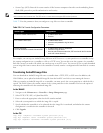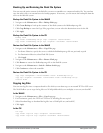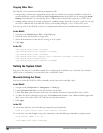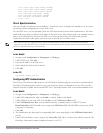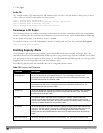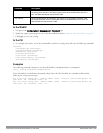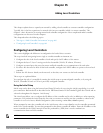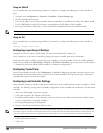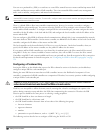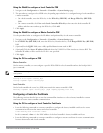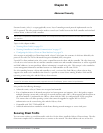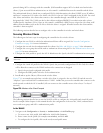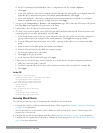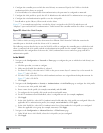
l SNMP, NTP, and syslog settings
l Hostnames, DNS and SMTP servers
l ACLs applied to ports
l Certificates
l RADIUS client details and RADIUS source interfaces
l Stateful firewall settings
l Customized captive portal pages and images, and the captive portal redirect address.
Configuring APs
APs download their configurations from a master controller. However, an AP or AP group can tunnel client traffic to
a local controller. To specify the controller to which an AP or AP group tunnels client traffic, you configure the LMS
IP in the AP system profile on the master controller.
Configuration changes take effect only after you reboot the affected APs; this allows them to reassociate with the
local controller. After rebooting, these APs appear to the new local controller as local APs.
Using the WebUI to configure the LMS IP
1. Navigate to the Configuration > Wireless > AP Configuration page.
n If you select AP Group, click Edit for the AP group name for which you want to configure the LMS IP.
n If you select AP Specific, select the name of the AP for which you want to configure the LMS IP.
2. Under the Profiles section, select AP to display the AP profiles.
3. Select the AP system profile you want to modify.
4. Enter the controller IP address in the LMS IP field.
5. Click Apply.
Using the CLI to configure the LMS IP
ap system-profile <profile>
lms-ip <ipaddr>
ap-group <group>
ap-system-profile <profile>
ap-name <name>
ap-system-profile <profile>
Moving to a Multi-Controller Environment
For a single WLAN configuration, the master controller is the controller which controls the RF and security settings
of the WLAN. Additional Dell controllers to the same WLAN serve as local switches to the master controller. The
local controller operates independently of the master controller and depends on the master controller only for its
security and RF settings. You configure the layer-2 and layer-3 settings on the local controller independent of the
master controller. The local controller needs to have connectivity to the master controller at all times to ensure that
any changes on the master are propagated to the local controller.
Some of the common reasons to move from a single to a multi-controller-environment include:
l Scaling to include a larger coverage area
l Setting up remote Access Points (APs)
l Network setup requires APs to be redistributed from a single controller to multiple Dell controllers
DellPowerConnectW-SeriesArubaOS6.2 | User Guide AddingLocalControllers | 666



